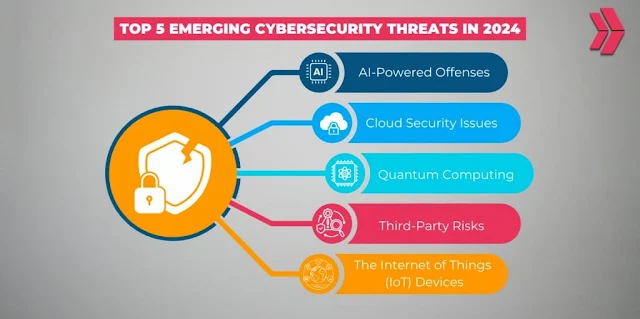Top 5 Cybersecurity Threats of 2024 You Should Watch Out For
As we navigate through 2024, the digital landscape continues to evolve at an unprecedented pace, presenting both opportunities and challenges for businesses and individuals alike. With the increasing reliance on technology, the threat of cyberattacks looms larger than ever. Cybercriminals are becoming more sophisticated, leveraging advanced technologies and strategies to exploit vulnerabilities. In this blog section, we will explore the top five cybersecurity threats of 2024 that everyone should be vigilant about, providing insights into their nature, potential impact, and preventive measures.
1. Advanced Ransomware Attacks
Ransomware has long been a significant threat, but in 2024, we are witnessing an alarming evolution in its tactics. Cybercriminals are now employing more advanced techniques, such as double extortion, where they not only encrypt data but also threaten to release sensitive information if the ransom is not paid. This shift is particularly concerning for organisations that handle sensitive customer data, as the reputational damage can be catastrophic.
The rise of Ransomware-as-a-Service (RaaS) has further democratized this threat, allowing even those with limited technical skills to launch attacks. Criminals can purchase ransomware kits on the dark web, making it easier for them to execute successful attacks. As a result, businesses of all sizes, from small enterprises to large corporations, are at risk. To mitigate this threat, organisations must invest in robust backup solutions, implement strict access controls, and educate employees about recognising phishing attempts, which are often the entry points for ransomware attacks.
2. Supply Chain Vulnerabilities
In an interconnected world, the security of an organisation's supply chain is paramount. In 2024, we are seeing a significant uptick in attacks targeting supply chain vulnerabilities. Cybercriminals are increasingly exploiting third-party vendors to gain access to larger organisations. High-profile incidents, such as the SolarWinds attack, have highlighted the potential for widespread damage when a single vendor is compromised.
These attacks can be particularly insidious, as they may go undetected for long periods. Cybercriminals can infiltrate systems through trusted suppliers, making it challenging for organisations to identify the source of a breach. To combat this threat, organisations must conduct thorough due diligence when selecting suppliers, implement continuous monitoring of third-party security practices, and establish clear protocols for incident response. Additionally, fostering a culture of cybersecurity awareness throughout the supply chain can help mitigate risks.
3. Artificial Intelligence-Powered Attacks
As artificial intelligence (AI) technology becomes more accessible, cybercriminals are harnessing its power to enhance their attack strategies. In 2024, we are witnessing a surge in AI-driven attacks, where malicious actors use AI algorithms to automate and optimise their efforts. This includes everything from crafting highly personalised phishing emails to developing sophisticated malware that can adapt to security measures in real-time.
The use of AI in cyberattacks poses a significant challenge for traditional security measures, as these attacks can be more difficult to detect and defend against. Organisations must therefore invest in advanced cybersecurity solutions that leverage AI and machine learning to identify and respond to threats in real-time. Additionally, ongoing training for employees on recognising AI-generated phishing attempts and other attack vectors is essential to bolster organisational resilience.
4. Internet of Things (IoT) Vulnerabilities
The proliferation of Internet of Things (IoT) devices continues to create new opportunities for cybercriminals in 2024. With billions of connected devices in homes and businesses, many of which lack adequate security measures, the attack surface for cybercriminals has expanded dramatically. These devices often collect sensitive data, making them attractive targets for hackers.
In many cases, IoT devices are deployed without proper security configurations, leaving them vulnerable to exploitation. Cybercriminals can leverage these vulnerabilities to gain access to larger networks, leading to potential data breaches or even physical damage. To address this threat, organisations must implement strict security protocols for IoT devices, including regular updates, strong authentication measures, and network segmentation to limit the impact of a potential breach. Furthermore, consumers should be educated on the importance of securing their IoT devices, ensuring that default passwords are changed and firmware is regularly updated.
5. Insider Threats
While external threats often receive the most attention, insider threats remain a significant concern in 2024. Employees, contractors, or business partners can unintentionally or maliciously compromise an organisation's security. Insider threats can take many forms, from data theft and sabotage to unintentional breaches caused by negligence or lack of training.
The rise of remote work has further complicated the landscape, as employees may access sensitive information from less secure environments. To combat insider threats, organisations must implement comprehensive security policies that include regular training on data protection and cybersecurity best practices. Additionally, employing user behaviour analytics can help identify unusual patterns of activity that may indicate a potential insider threat. Creating a culture of transparency and trust can also encourage employees to report suspicious behaviour without fear of repercussions.
Conclusion
As we progress through 2024, the cybersecurity landscape continues to evolve, presenting new challenges for organisations and individuals alike. The threats outlined above—advanced ransomware attacks, supply chain vulnerabilities, AI-powered attacks, IoT vulnerabilities, and insider threats—are just a few of the pressing issues that require immediate attention. By understanding these threats and implementing proactive measures, businesses can strengthen their cybersecurity posture and safeguard their critical assets against the ever-evolving landscape of cybercrime. It is imperative that organisations remain vigilant, adaptable, and committed to fostering a culture of cybersecurity awareness to navigate the complexities of the digital age successfully.


Post a Comment for "Top 5 Cybersecurity Threats of 2024 You Should Watch Out For"